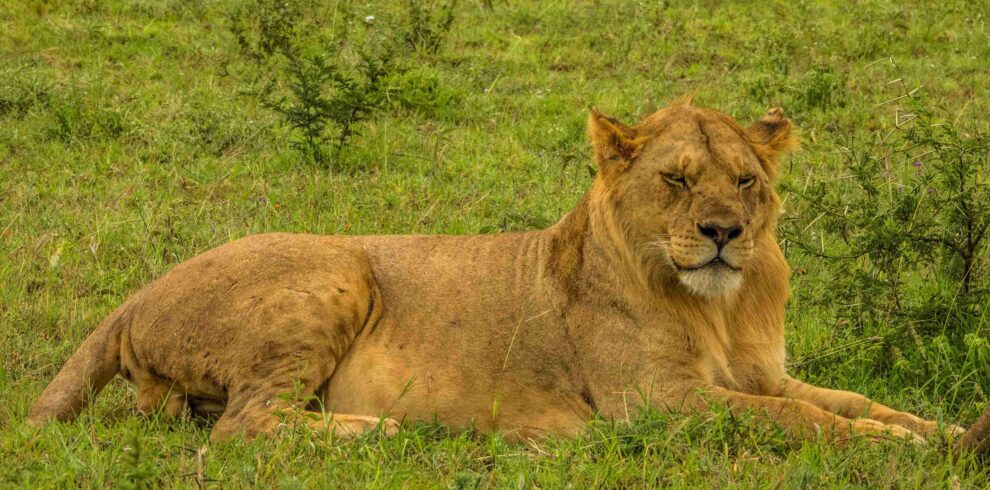- 1
- 8
- 1
- 1
- 5
- 7
- 11
- 1
- 1
- 2
- 1
- 1
- 1
- 1
- 2
- 3

- Jan
- Feb
- Mar
- Apr
- May
- Jun
- Jul
- Aug
- Sep
- Oct
- Nov
- Dec
Famous For: Ngorongoro Crater, Big Five wildlife, Maasai culture
Ecosystem: Volcanic caldera, highland forests, grasslands, plains
Key Wildlife: Lions, black rhinos, elephants, leopards, buffaloes, flamingos
Located in northern Tanzania, just west of Arusha, the Ngorongoro Conservation Area (NCA) is one of Africa’s most remarkable protected areas. It combines breathtaking landscapes, an extraordinary concentration of wildlife, and deep cultural and archaeological significance. At the heart of this UNESCO World Heritage Site lies the Ngorongoro Crater, the world’s largest intact volcanic caldera and one of the best places in Africa to see wildlife up close in a naturally enclosed environment.
But the Ngorongoro Conservation Area is far more than just the crater. It spans over 8,000 square kilometers, encompassing highland forests, grasslands, woodlands, rivers, and the beginnings of the Serengeti plains. It’s also a place where wildlife and people co-exist, as the area is home to Maasai pastoralists who continue to live and graze their cattle here under traditional practices.
The centerpiece of the conservation area, the Ngorongoro Crater, was formed about 2 to 3 million years ago when a massive volcano exploded and collapsed on itself. Today, the crater spans about 19 kilometers (12 miles) in diameter and is around 600 meters (2,000 feet) deep. Its floor is a mix of grasslands, swamps, forests, and a shallow soda lake—Lake Magadi—creating a perfect microcosm of East African wildlife habitats.
The crater is often described as a “natural zoo” due to its high density of wildlife in a relatively small area. It’s not uncommon to spot the Big Five—lion, leopard, elephant, rhino, and buffalo—within a single day.
Ngorongoro is one of the best places in Africa to view a diverse range of animals in a short time, especially within the crater itself. Some of the prominent species include:
In addition to mammals, the crater is teeming with birds, particularly around Lake Magadi. Flamingos, storks, pelicans, herons, crowned cranes, and various raptors create spectacular birdwatching opportunities.
The surrounding highlands also support less frequently seen animals like cheetahs, wild dogs, and mountain reedbucks.
While the crater draws most of the attention, the greater Ngorongoro Conservation Area offers much more:
Ngorongoro is one of the few protected areas in Africa where human habitation is legally permitted. Over 40,000 Maasai people live within the conservation area, practicing traditional livestock herding. The conservation model aims to balance wildlife protection with the rights of local communities.
Visitors can engage with Maasai culture through village visits, guided walks, and cultural presentations—learning about traditional ways of life, ceremonies, and their symbiotic relationship with the land and animals.
The most popular activity, especially inside the crater. Early morning drives offer the best lighting and chance to see predators in action.
Permitted in the highlands and around Empakaai and Olmoti Craters, often guided by armed rangers.
Organized visits to Maasai bomas (homesteads) provide insights into traditional lifestyles.
Particularly good around the crater lakes and in the highland forests.
Olduvai Gorge Museum is an essential stop for those interested in early human history.
Ngorongoro can be visited year-round, but the experience may vary:
Lodging ranges from luxury lodges on the crater rim to mobile camps and mid-range lodges in nearby Karatu or Ndutu:
Booking early is essential, especially for crater rim lodges, which offer spectacular sunrise and sunset views.
The Ngorongoro Conservation Area offers an unforgettable mix of breathtaking scenery, world-class wildlife viewing, cultural encounters, and deep historical significance. Whether you’re watching elephants roam beneath misty crater walls, trekking along highland trails, or standing where early humans once walked, Ngorongoro delivers a safari experience that is both profound and personal.
It is a destination that stirs the soul, reminding us not only of the wild beauty of East Africa but also of our shared human heritage.

